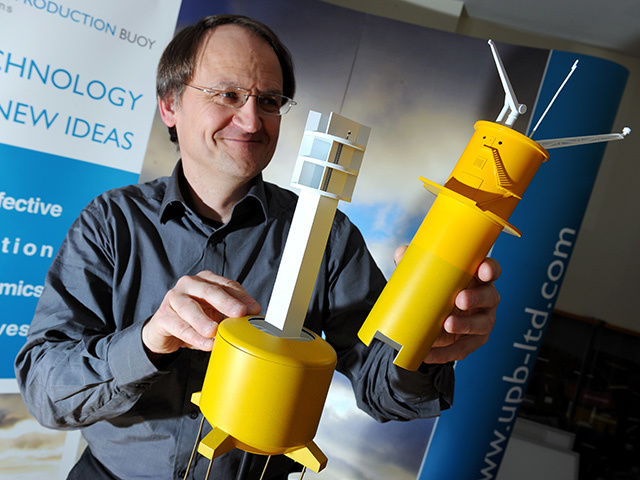
A Scottish company has developed a low-cost, buoy-based autonomous oil production system that is to be deployed in the North Sea on former Hess-operated assets.
The concept has been under development for seven years and is designed for series manufacture in large numbers. It is the offshore equivalent of the many thousands of nodding donkey pumping systems in service onshore worldwide, producing tiny fields and squeezing old ones.
The North Sea prize for the offshore nodding donkey is an estimated 2billion barrels of oil.
Unmanned Production Buoy (UPB) of Banchory expects to have its Angus field onstream in 2016. The long-term goal is to build 100 systems for deployment in European waters and elsewhere.
And UPB’s founder/chairman Richard Selwa sees the buoy system as a key enabler to accessing reserves that might otherwise be left stranded in numerous small pockets that are currently deemed non-commercial and where companies have given up, sometimes on difficult fields that have been hard to produce.
o The average oil discovery in the UK North Sea is 10-15million barrels
o Over 250 such UKCS fields require an economic solution
o UK potential host platforms are ageing and some face decommissioning or have already gone
o Existing autonomous technology solutions require over 30million barrels
With DECC anticipating 16 fields to be decommissioned in the next three years and many more over the coming decade or so, satellite tie-back opportunities will become increasingly restricted.
Yet a further 14-24billion barrels of reserves remain on the UKCS. If the maximum recovery is to be achieved, new solutions are required.
Selwa and his team at UPB have developed and tested and patented their system.
The company successfully bid in the 27th UK offshore round for licences covering the formerly Hess-operated Fife, Flora, Fergus and Angus fields.
UPB now plans to redevelop the area using its technology, moving the floating production system from field to field. The code-name is Project Hoy. In this case, the target is recovery of tail-end reserves.
The company plans to redevelop the Angus field in the first instance and operate that for approximately two to three years. Following this, the buoy would be redeployed to the redeveloped Fife field.
UPB currently holds the relevant licence 100% and is farming down equity in the fields.
Selwa told Energy that the UPB system could as effectively handle early field and marginal production projects throughout the North West Europe Continental Shelf, including the Celtic Sea and offshore Ireland.
“We are a new generation oil company,” said Selwa. “Our business model is to be a technology leader and work with partner oil companies and governments to develop smaller or stranded fields.
“UPB will achieve this through two key principles . . . standardised design and mass manufacture of UPBs. The company has a vision to build its first units for its own fields then move to build 100 further of these simple systems.”
Explaining the nodding donkey analogy, Selwa said UPB’s system is based on the same principle.
The package will have a small environmental footprint, providing a combination of sealed floating production systems and a fully recoverable storage tank.
The design is said to be inherently safe and would normally be unmanned. Each unit would be expected to work autonomously on around five different fields over its life. Designed production capacity will be up to 15,000 barrels of oil per day.
Typical economic field developments in the UKCS using the UPB system would be in the range of 3-10million barrels recoverable and at production rates of 1,500 to 10,000bopd.
UPB’s technology is centred on the use of temperature-based stabilisation, an established onshore method that uses heat and a long residence-time in large tank, to separate oil and water.
The package will not carry gas processing kit. Instead, production rates would be constrained to give the required fuel gas for process heating and power generation.
Selwa: “The system is 100% recoverable and redeployable and can operate in 60-600m. A deep-water system design is already well under way.”
There are three major components to the system, a partially submerged buoyant structure (the production buoy), a subsea storage tank with separation (tank and base) and subsea infrastructure.
The buoy will contain simple but proven degassing and desanding functions, sand cleaning and disposal, power generation and controls. The design currently allows for up to five subsea trees that can be connected to the buoy with flexible risers. The buoy would power and control a subsea water injection package.
“We have gone about this differently,” said Selwa. “We have sat down with our manufacturers and suppliers and set about building a philosophy around scale.
“Yes, the first system will be the most expensive and requires pre-investment, but when the standard units are manufactured, we expect their cost to come down considerably. It is what the automotive and aircraft industries have done for years and what we will do too.”